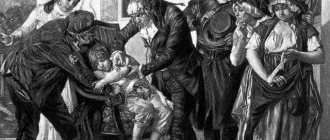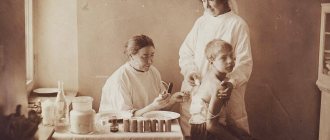WHO against smallpox
Work on the WHO Global Smallpox Eradication Programme. A Niger resident is given a vaccine using a needle-free injector, 1969.
Over the past 21 years, doctors from 73 countries have jointly rid humanity of a viral infection that has killed millions of people.
The idea of the program was simple: by mass vaccination, to block the spread of the smallpox virus until there was only one patient left on Earth. Find him and put him in quarantine. When the chief sanitary inspector of the USSR Ministry of Health, Viktor Mikhailovich Zhdanov, proposed such an idea at a WHO session, this unknown person was only 4 years old. When he was finally found, the boy grew up to become a skilled chef.
How the USSR interfered with the fight against smallpox
On June 12, 1958, no one yet knew where this last patient would be found. There were 63 states in the world with smallpox outbreaks. All these countries were developing. And although the idea of helping them was expressed by the not very popular delegation of the Soviet Union, which was at odds with half the world, the resolution was adopted unanimously. There were two reasons for the consensus: financial and medical. Firstly, smallpox was regularly imported from the colonies to first world countries, so it was necessary to spend a billion dollars a year on prevention. It’s easier to just vaccinate all of humanity, it will cost a hundred million, and it will only be needed once. Secondly, more people began to die from complications as a result of vaccination than from imported smallpox.
The Soviet Union was one of the founding states of the World Health Organization, but until 1958 it demonstratively did not participate in its work. Now that relations with the outside world were improving, a program was needed that would attract universal approval. The political situation and the dreams of Soviet doctors coincided for a while. The USSR generously donated millions of doses of smallpox vaccine to WHO, and WHO called on world governments to vaccinate their populations with this drug.
Development in Russia
Vaccination also came to our country from England. Not the first, but the most famous to be vaccinated were Empress Catherine the Great and her son Paul. The vaccination was carried out by an English doctor who took biomaterial from the boy Sasha Markov - he later began to bear the double surname Markov-Ospenny. Half a century later, in 1801, with the light hand of Empress Maria Feodorovna, the surname Vaktsinov appeared, which was given to the boy Anton Petrov, the first to be vaccinated in Russia using Dr. Jenner’s method.
In general, the history of smallpox in our country can be studied by last name. Thus, until the beginning of the 18th century, there were no written references to smallpox in our country, but the names Ryabykh, Ryabtsev, Shchedrin (“pockmarked”) indicate that the disease existed, as elsewhere, since ancient times.
After Catherine II, vaccination became fashionable, thanks to the example of the august person. Even those who had already been ill and acquired immunity from this disease were vaccinated against smallpox. Since then, vaccinations against smallpox have been carried out everywhere, but only became mandatory in 1919. It was then that the number of cases dropped from 186,000 to 25,000. And in 1958, at the World Health Assembly, the Soviet Union proposed a program to completely eliminate smallpox from the world. As a result of this initiative, no cases of smallpox have been reported since 1977.
Iraq's successes
The first country where smallpox was eradicated in this way was Iraq. The local prime minister, Abdel-Kerim Qassem, sought Khrushchev's friendship. In August 1959, a detachment of Soviet doctors arrived in Baghdad. For two months, they traveled all over Iraq on UAZ sanitary loaves, distributing the vaccine and teaching local doctors how to use it. There were many women in the detachment, because in a Muslim country male doctors were not allowed to vaccinate women and girls. Every now and then we had to wear hijabs, but in general the attitude was favorable. Until October 7, 1959, when young Saddam Hussein shot at the prime minister's car and wounded him. At that time, Kassem remained alive, but unrest began, and epidemiologists were called home. Iraqi doctors independently brought the matter to complete victory - later there was only one outbreak of the disease, and that was an imported one.
The program had such success where there was its own intelligentsia. Doctors enthusiastically accepted help, explained to the population the importance of vaccination and made sure that there were no foci of infection. This came out in Iraq and Colombia, but there were only two dozen such states. After 10 years, WHO admitted that in 43 countries there was no progress: officially there were 200 thousand sick people, but in reality there were probably 10 times more. We adopted a new, intensive program - WHO specialists went to developing countries to organize on the spot what local authorities were unable to do. And events began in the spirit of the Strugatsky novels.
The director of the program was the American epidemiologist Daniel Henderson, who successfully fought smallpox brought to the United States. At 38 years old, he was able to understand a stranger in five minutes of conversation and accurately determine whether he should be accepted into the team, and for what place. Henderson, based in Geneva, conducted the work around the world. He turned to new technologies, without which mass vaccination was too slow.
Winner of the Stalin Prize – carrier of smallpox
It all started in December 1959, when a plane from India landed at Vnukovo. On board was the famous poster artist Alexey Kokorekin. He is well known from the posters of the Great Patriotic War: “For the Motherland!”, “Death to the fascist vermin!” and others. Alexey Alekseevich was twice a laureate of the Stalin Prizes.
53-year-old Kokorekin had to get the appropriate vaccinations before traveling to an exotic country, but, most likely, he persuaded doctors to simply mark the vaccination. The trip was interesting, the artist held many meetings, conversations, lectures and interviews. Alexey Alekseevich even attended the burning ceremony of an Indian Brahman who died of smallpox.
A.A. Kokorekin
Source: pinterest.com
Alexey Alekseevich arrived earlier (his wife was expecting him the next day). At the airport, he went through all customs and border procedures and went... to his mistress. He coughed a little, but it was December - and who doesn’t cough in winter? The next day the artist was already at home and distributing gifts. But soon he became worse, his cough got worse, his temperature rose, and he had to go to the emergency doctors. Kokorekin was immediately hospitalized with a suspected complicated form of influenza. However, the patient was fading away right before our eyes, the rash that appeared was considered an allergic reaction, and by the morning of December 29, Kokorekin died. Academician N.A. was invited to the autopsy. Kraevsky, and by a lucky coincidence an old man came with him, who had come to visit the academician as a pathologist from Leningrad. The old doctor looked and said: “Yes, my friend, this is variola vera - black smallpox.”
Military at the forefront of the fight
The US military provided WHO with needleless injectors - pneumatic devices with a pedal that injected the vaccine under the skin. The idea came from a grease gun. Workers in French shipyards complained that they sometimes accidentally injected themselves with lubricant. If such a gun is loaded with vaccine, one person per shift can easily vaccinate a thousand. No electricity required - just compressed air.
A device like this cost the same as a Volkswagen Beetle, but it worked wonders. He cleared smallpox from Brazil, West and South Africa - places where the population could easily gather at the call of Catholic missionaries, who also served as epidemiological surveillance. It was enough to promise the distribution of food, and nomadic Indians from the Amazon jungle and cannibalistic pygmies from the Zairean rainforest appeared in response to the cry.
Dr. Ben Rubin came up with an even more powerful tool - the bifurcation needle. Its forked sting held a drop of the drug, only 0.0025 milliliters. For reliable vaccination, it is enough to slightly prick the shoulder 10-12 times. The developer donated the rights to his needle to WHO. This saved millions and made it possible to recruit volunteers without any medical training.
Ivan Okay's needle
Soviet scientist Ivan Ladny in Zambia destroyed one outbreak after another until he found a person who was spreading the smallpox virus to the entire country. It turned out to be a shaman who did variolation. His bamboo tube contained material from the purulent scabs of a mild case of smallpox. For a fee, this rubbish was injected into an incision in the skin. It could induce immunity for many years, or it could provoke a fatal disease. What to do with this shaman? Ladny suggested that he change - a set of variolator for a bifurcation needle. The deal took place, and the shaman turned from an enemy into an assistant.
In 1970, Central Africa was considered free of infection, when suddenly this diagnosis was made to a 9-year-old boy in a remote village. Where could smallpox come from if it is transmitted only from one person to another? A sample of material from the vesicles on the boy’s body was sent to the WHO Collaborating Center in Moscow, where Svetlana Marennikova examined it under an electron microscope and determined that it was a smallpox virus, not natural, but monkeypox, known since 1959. This is how we learned that people can get this infection from animals. Moreover, monkeypox was found in animals in the Moscow Zoo. Marennikova had to vaccinate the animals, including stabbing the ear of a huge Amur tiger in a special pressure cage. But the most important thing about this discovery is that the smallpox virus has no host other than humans, which means the virus can be isolated and left without prey.
Smallpox vaccinations: the main thing that still distinguishes older people
Daria Yudkevich, October 26, 2021, 00:05 — REGNUM Smallpox is one of the oldest infectious diseases that has literally decimated the inhabitants of different countries and continents for many centuries. According to ancient Egyptian manuscripts, smallpox originated in Central Africa. Egyptian mummies with traces of smallpox prove its existence in Egypt in the third millennium BC. Chinese sources mention smallpox as early as the 12th century BC; a smallpox-like disease is described in Indian documents from the 9th century BC. Much later, only in the 4th century after the birth of Christ, smallpox spread from Northeast Africa to Arabia, and two centuries later to Europe, where it literally scourged countries for two centuries: epidemics were noted in France, Italy, and Spain. Smallpox was introduced to Russia, as it was to Germany, in the 15th century. A hundred years later, Spanish colonialists brought smallpox to America, where they also used it as a bacteriological weapon to destroy the indigenous population of Mexican lands - through contaminated clothing that was hung in the forest (a method they tested during the Reconquista against the inhabitants of the Cordoba Caliphate). In the mid-16th century in Brazil, smallpox killed about 100,000 people in one province alone. But the British brought this disease to North America, and in 1616-1617, the largest epidemic among Indians was recorded on the East Coast, including the almost complete extermination of the tribe living in what is now the state of Massachusetts.
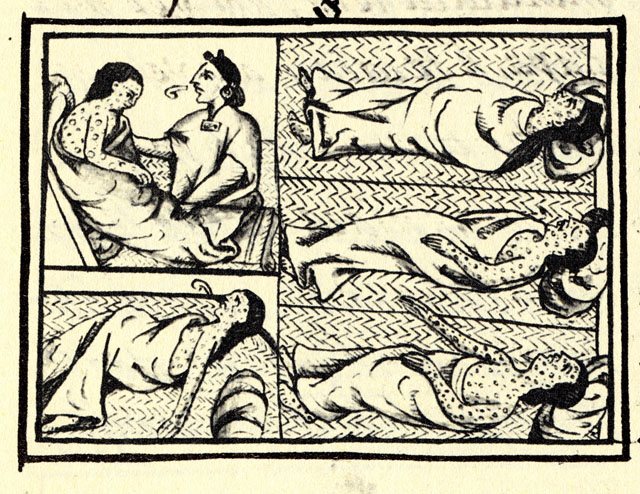
Accompanying drawings to the text from the Florentine Codex (1540-1585) A Nahua Indian suffers from smallpox (the era of the Spanish conquest of central Mexico)
Smallpox became most widespread in the world in the 18th century. In some years in Europe, up to 10-12 million people fell ill with it, of whom from 25 to 40% died. Smallpox not only killed, it left many blind, and in the vast majority of cases it literally disfigured people:
“The pestilence or plague was more deadly, but it visited our shores only once or twice in people’s memory, while smallpox remained persistently among us, filling the cemeteries with the dead, tormenting with constant fear all those who had not yet suffered from it, leaving the people whose lives she spared are ugly signs, like a mark of her power, making the child unrecognizable to her own mother, turning the beautiful bride into an object of disgust in the eyes of the groom,” wrote the English historian Thomas Macaulay (19th century).
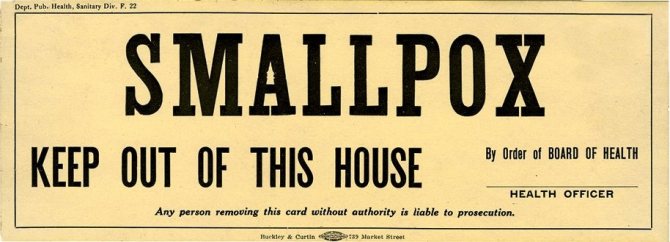
Smallpox Quarantine Warning, California, circa 1910
The source of infection is the sick person throughout the illness, regardless of what form of smallpox he has, with or without a rash (although the severe form with profuse rashes is especially contagious). The virus is found in large quantities in smallpox crusts, but the main route of transmission is airborne droplets, as well as airborne dust (transmission by shaking infected clothing, which was what the Spanish colonialists used). The disease can take a mild form or extremely severe, with the addition of secondary infections and complications (encephalitis, meningitis, myocarditis, tracheitis, otitis media, blindness). In various forms of smallpox, not only the skin is affected, internal organs also undergo changes, necrosis and hemorrhages occur in the bone marrow, necrotizing tonsillitis, and sometimes damage to the lungs. The kidneys, liver, and heart undergo dystrophic changes. Rashes form not only on the skin, but also on the mucous membranes of the nasopharynx, trachea, esophagus, intestines, and stomach; in such cases, the vesicle quickly breaks through and erosion forms. A typical case of the onset of smallpox is a temperature of up to 40 degrees, severe weakness, headache and muscle pain, anxiety, insomnia, pain in the lumbar and sacral area, tachycardia, cough, runny nose. The rash appears on the 2nd–3rd day of the onset of the disease, localizing on the neck, chest and thighs. This rash disappears on average within a day, and on the 3rd-4th day a smallpox rash proper appears, quickly spreading throughout the body. At the same time, the temperature drops - until the 9-10th day, when it rises again to 39-40 degrees, and the so-called. "suppurative fever" The patient's condition is especially difficult during this period. Improvement occurs on the 11th-12th day. From the 16th to 17th day, brown crusts form, which fall off on the 30th to 40th day, leaving behind gradually fading spots and scars.
The famous Arab physician Ibn Sina , better known to us as Avicenna, became the first doctor to describe smallpox as a contagious disease. The causative agent of smallpox - variola virus - was first discovered by Bust (1886), but what about the discovery of the vaccine? The first vaccinations against smallpox existed in the Middle Ages in the East, in the 8th century in India, in the 10th century in China, they were known in Siberia and the Urals, in Africa and Scandinavia. T.N. variolation was an inoculation of smallpox pus from a mature pustule of a smallpox patient. In 1718, this method of vaccination was brought to Europe by the wife of the British ambassador in Constantinople, who vaccinated her little son. In England, this vaccination was given to the family of the British King George the First. Variolation gave a 2% mortality rate, but they abandoned it not only and not so much for this reason: it did not provide a guarantee and itself often caused epidemics. In France, variolation was prohibited by law in 1762; England abandoned it in 1840.
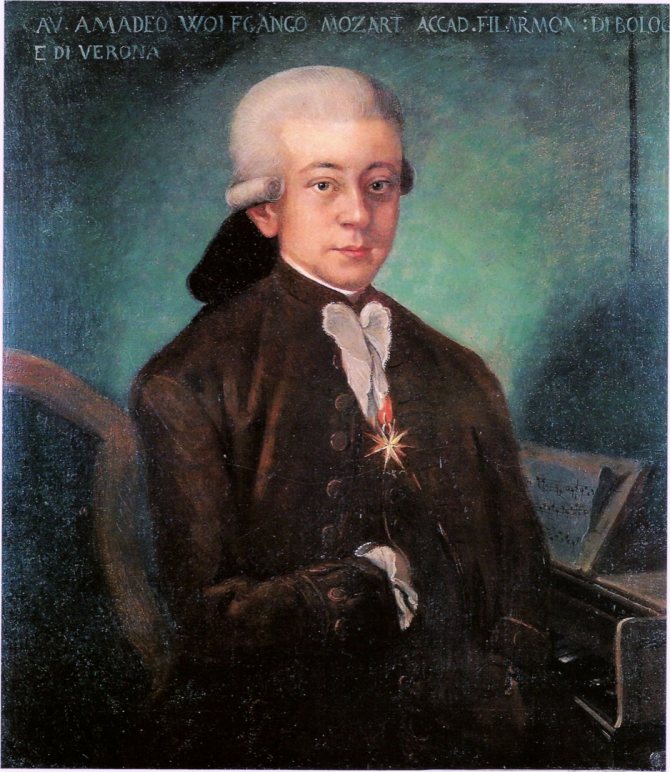
In 1767, 11-year-old composer Wolfgang Amadeus Mozart survived a smallpox outbreak in Austria.
The discovery of an effective smallpox vaccine belongs to the English doctor Edward Jenner, who in 1796 inoculated an eight-year-old boy with cowpox (the word “vaccine” itself comes from the Latin vaca - cow): the disease took hold, developed only in two vaccinated areas, proceeded normally, after a month and a half Jenner inoculated with natural human smallpox, which did not take off. It was concluded that exposure to cowpox imparts immunity to smallpox. A few years later, smallpox vaccination became mandatory in the English army, and in 1807 in Bavaria it was declared mandatory for the population. Catherine the Second vaccinated herself (the boy from whom the material was taken received nobility, the surname Markov-Ospenny and a coat of arms depicting a hand with a vaccination).
Jenner's discovery reduced the incidence of smallpox, but since only part of the population was vaccinated, epidemics continued into the next two centuries. At the beginning of the 20th century before World War I, there were large outbreaks of this disease in Europe, but after the war the situation became significantly worse - not only in Europe (where 167,300 cases were reported in 1920 alone), but also in the United States. In the 30s, the incidence was reduced, mainly due to high-quality and widespread vaccination. The weakening of preventive measures led to the fact that since 1943, large epidemics again engulfed some European countries (but not the USSR, which eliminated smallpox by 1936). Statistics from the third quarter of the 20th century show that the number of countries where cases of smallpox were recorded gradually decreased, as did the number of cases - although very unstable. So, if in 1950 cases were recorded in 82 countries of the world (216,555 diseases), then the next year - in 80 countries, but with a much larger number of patients (486,508) - the epidemic was in Asia; in 1952 - 69 countries (154,734 patients), then a decrease, again an outbreak in 1958 (again in Asia) - a year that became special for the world fight against smallpox, to which we will return. The real difference only becomes noticeable in the 70s, when the statistics began to decline sharply and steadily.
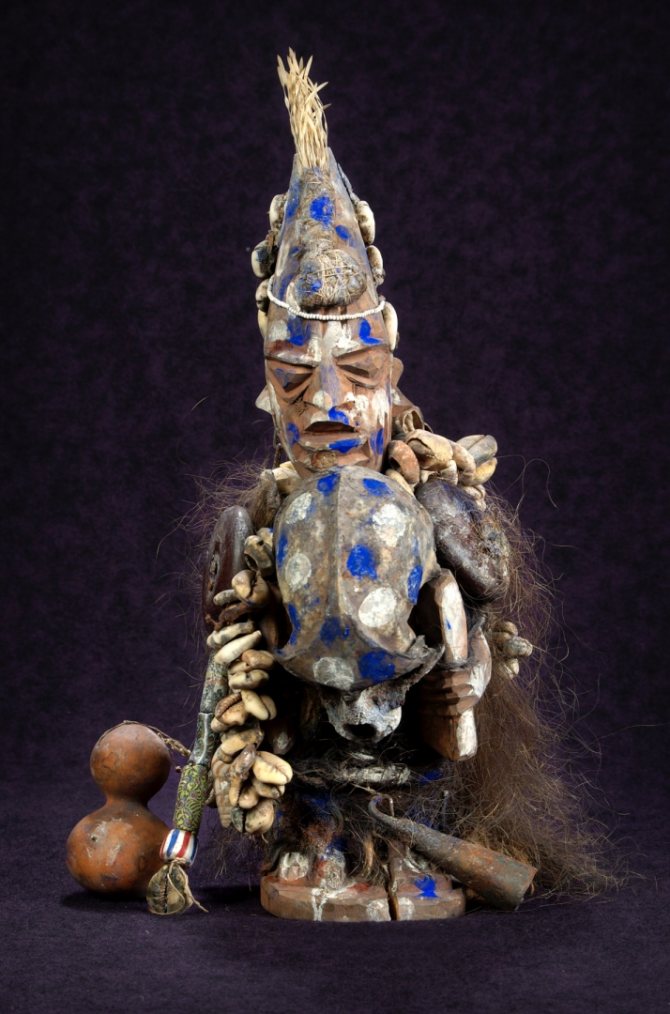
Statue of Sopona, a Yoruba god believed by local tribes to cause disease
However, before that time, the world's fight against smallpox still had a very long way to go. The existence of the vaccine discovered by Jenner did not help defeat the disease on a global scale; even at the beginning of the 20th century, smallpox continued to be the most common viral infection. The most striking thing is that, despite this fact, since the mid-19th century, neither the agenda of international conferences nor the summary of international sanitary rules included smallpox. Only in 1926, at the XIII International Sanitary Conference, after a heated discussion, smallpox was included in the list of especially dangerous diseases, albeit with the amendment that mandatory declaration was required only in the case of epidemics, but not individual cases of the disease.
Meanwhile, the development of international communications, increasing the mobility of people and at the same time complicating the implementation of quarantine measures in such conditions, made itself felt: smallpox foci existed in Asia, Africa and South America, posing a possible threat of epidemics if preventive measures were weakened. Smallpox appeared in new countries every year, and it became obvious that no country was immune from its importation.
In 1958, at the XIth session of the World Health Assembly, a proposal made by the Soviet delegation to eradicate smallpox throughout the world was adopted. The historic resolution established a global program, as a result of which, through joint efforts, it was possible to gradually overcome this disease. In 1971, smallpox was eradicated in South America, four years later in Asia, and two years later in Africa, where the last case of smallpox in the world was recorded on October 26, 1977. Exactly one year later, to the day, WHO declared the smallpox virus destroyed in nature. Now it exists only in laboratory conditions (which, by the way, leaves the potential for infection, as happened in England in 1973 and 1978).
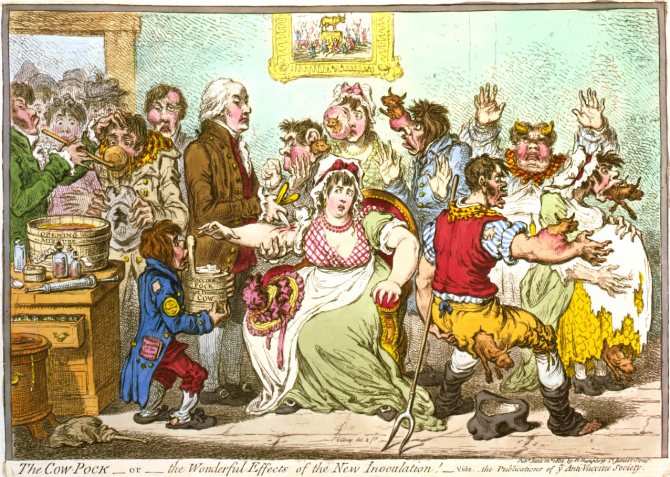
Cartoon created in 1802, when Edward Jenner proposed vaccinating animals with smallpox to protect humans
The World Smallpox Eradication Program was made effective by a combination of factors: clear coordination through a single center (WHO) and effective management of actions, supply of high-quality vaccine, vaccination using methods that eliminate errors in vaccination techniques, and the creation of an epidemiological control service. At the WHO session, where victory over smallpox was officially declared, the role of the USSR in this achievement was noted as a country that not only initiated the smallpox eradication program, but also actively participated in its implementation. In the history of world medicine, this is the first case of a global victory over one of the deadliest infections.
Indian nursery
The main breeding ground for smallpox in its deadliest form remained the Indian subcontinent - India, Pakistan, Bangladesh, Nepal. WHO Director General Marcolin Candau did not believe that anything could be eradicated in India at all and promised to eat a jeep tire if he was wrong. The fact is that the reporting in those parts was extremely bogus. Local epidemiologists quickly found their bearings: they signed up for the WHO program, received good salaries in foreign currency, dismantled the jeeps allocated to them as personal vehicles, and sent Henderson reports on 100% vaccination of their regions. And thousands of cases of smallpox were attributed to the poor quality of vaccines, primarily Soviet ones. Like, it’s hot here, the Russian drug is decomposing. Only the bosses were distinguished by such meanness. Among the rank and file there were always enthusiastic doctors who were able to go on call all night to a mountain village with a torch in hand, removing earth leeches from their feet. Walking side by side with them were staff from the global program.
Soviet doctors, who understood the false statistics, began to go to every outbreak. They came up with the idea of mobilizing all the district’s health workers for this purpose for a week - the authorities allowed it, and Indira Gandhi directly called on the population to help WHO staff. Canadian student volunteer Beverly Spring first thought of sending volunteers to the market to ask if there was smallpox in these places. The information received was always accurate. Next, vaccinators moved to the site, and after vaccination, a watchman, usually a relative, was assigned to the patient’s house, who recorded everyone who came. In 1975, smallpox was no longer endemic in India, and Henderson sent Kandau an old Jeep tire. But he did not eat it, because by that time he had retired.
Ethiopia is the last country to defeat smallpox
The jeeps and people liberated in Asia were thrown into the last bastion of smallpox - Ethiopia. There, doctors did not keep fake statistics, because healthcare did not exist at all. The Muslim part of the country turned out to be more enlightened and loyal to vaccination - scattered pockets of the disease were quickly eliminated there. The situation was worse in the Orthodox regions, where the clergy was engaged in variolation, saw it as a source of income, and therefore opposed the eradication of smallpox. Two local vaccinators were even killed in the line of duty. But when Emperor Haile Selassie was overthrown and then strangled to death with a pillow, the new government needed international recognition and began helping the WHO. It couldn't just close the border with Somalia. In the Ogaden Desert, Somali guerrillas captured a Brazilian smallpox specialist and released him only after the personal intervention of the UN Secretary General. Traces of smallpox led to Somalia. Despite the war that this quasi-state waged with Ethiopia, employees of the Global Program identified all the sick people among the nomads. They were taken to the hospital in Marka. On the way, I met a friendly guy named Ali Mayau Mullin, who not only knew the way, but even got into the jeep and showed me how to get there, because he worked as a cook in that very hospital. In a few minutes in the car, Ali contracted smallpox and went down in history, because he was the very last person to become infected on Earth. When he recovered, the WHO waited some time and announced a reward of a thousand dollars to anyone who would find a smallpox patient. This money never went to anyone.
Mikhail Shifrin
Mikhail Shifrin
Why didn't the milkmaids get sick?
The man destined to find a safer and more effective way to prevent smallpox was named Edward Jenner. He was born near Bristol, in the town of Berkeley (Gloucestershire) on May 17, 1749. His father Stephen was a Church of England minister.
When Edward was eight years old, they decided to send him to a free boarding school, and soon the school was engulfed by a terrible smallpox epidemic. All students who had not undergone it previously, including Edward, were hastily subjected to variolation. The boy, already at a loss in an unfamiliar environment, had to endure a futile and potentially dangerous training with inevitable bloodletting, fasting and enemas. After six weeks, the weakened, exhausted, frightened and unhappy child was vaccinated, and then he was placed in the infirmary along with children who had already contracted smallpox and were for the most part in a serious and sometimes hopeless condition. This frightening experience had serious psychological consequences for Edward.
At school, Edward was interested in biology and decided to become a doctor. He did not achieve any particular academic success, but his knowledge was enough to become a student of junior surgeon John Ludlow at the age of thirteen and study with him for six years. Working under Ludlow, he listened with interest to what the villagers were telling their doctor. In particular, in 1768, already at the end of his studies, he heard talk that milkmaids who were infected with cowpox never subsequently became ill with human smallpox. It was this story that led Jenner to the idea that deliberately infecting people with cowpox could protect them in the future from contracting the terrible disease.
Before Jenner had the opportunity to test the validity of his idea, he moved to London, where he began studying at St. George's Hospital. Its chief surgeon, John Gunther, was soon to gain a reputation as England's most distinguished surgeon. And Jenner, while working in the hospital, gained considerable experience in using the latest surgical techniques.
But after spending two years in London, Jenner dreamed of a quiet and peaceful life in the English countryside, he desperately wanted to return to Berkeley.
In Berkeley, Jenner's activities were not limited to his duties as a country doctor. He found time to play the violin and flute, and also composed ballads and songs. Having heard that two French brothers had built a balloon to transport passengers and, having filled it with hydrogen, had flown a considerable distance, he himself made a huge balloon out of silk and also filled it with hydrogen. Edward Jenner became the first Englishman to build a hot air balloon.

Jenner was also interested in a mysterious disease first described in 1772 by William Heberden. Geberden called this disease angina pectoris, now we call it angina pectoris. Jenner performed an autopsy on a patient who died after an attack of angina pectoris. Having examined the heart and not finding, by the means on which he could count, any cause of the sudden death of the patient or the symptoms preceding it, he proceeded to make a transverse section of the heart very close to its base, and suddenly the scalpel rested on something very hard and hard. Further study allowed us to establish the truth: the coronary arteries turned into ossified canals.
The calcification of the coronary arteries discovered by Jenner first led him to the idea that it was the obstructive lesion of these arteries that was the cause of angina pectoris and sudden death, which so often overtook people suffering from this disease. This suspicion turned into certainty after subsequent autopsies of those who died of angina confirmed the indispensable presence of one or more blocked coronary arteries.
But the question of a possible connection between cow, horse and natural smallpox still occupied him. At a medical conference, he met with a certain Mr. Frewster and learned that in 1765 he presented a report to the London Medical Society on cowpox and its ability to prevent smallpox. (The report was never published.) Jenner found Fruster's story about the possible interdependence between the two diseases extremely interesting. As a result, he and Früster devoted almost all of their time at the conference to discussing various types of smallpox, although members of the Society believed that the problem was of no medical importance.
Today we know that smallpox, cowpox, pigpox, horsepox and a great many other types of animal pox are caused by viruses of the Orthopox family and that all of these diseases can also be infected by humans. Infection with one type of disease creates immunity in a person against all other diseases in the group. Jenner did not know this, but in December 1789 events occurred whose enduring historical significance he immediately appreciated.
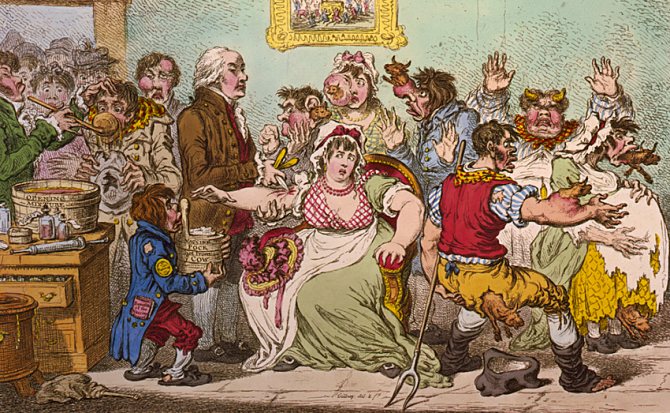
The anti-vaccination movement began shortly after Edward Jenner developed the first smallpox vaccine. James Gillray. “Cowpox, or the miraculous effect of a new vaccination!” (1802)
Wikipedia

